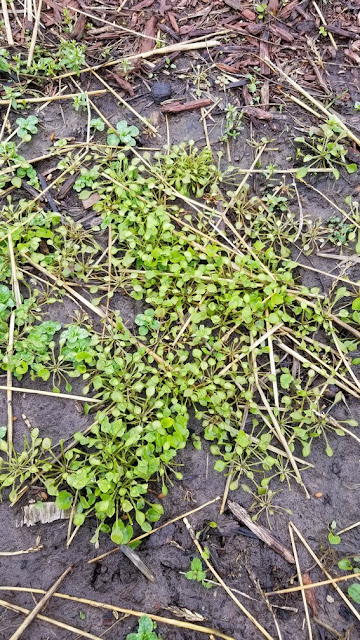Between long covid and a cool, wet spring, the vegetable garden is growing late.
The seeds I was able to direct-sow in early spring are doing okay, but could certainly use more sun. Those I started for the later crops are faring so-so, depending upon their tolerance for low light and temperature. The 'German Johnson' tomatoes and the basils really suffered from being moved outdoors to the cold frame too soon. It looked like we were getting into a nice spring when I put them out, and I didn't get them back indoors soon enough when that didn't pan out.
'German Johnson'
What they looked like before I potted them up and moved them to the cold frame:
I've got them back under lights in the cellar, so I expect them to green up. Also, it's supposed to be in the low 80s next week with sunshine, so they'll be able to go back outside then. When I plant them in the garden, I'll just have to plant them deep, or lay them down and leave just the top leaves above ground. Tomatoes are good about putting on roots anywhere they are in contact with the soil, and in fact, some people recommend planting them that way just for that purpose. Their lack of chlorophyll right now is a problem, but I'll add composted cow manure to the soil when I plant them, and I expect they'll be fine.
The basils will also make up for their lack of heat and sun when I put them out, but I'm sorry to have given all these plants a less than optimal start. Every year, it's something. Last year, things flooded with too much rain, and if it rains much more today or tonight, that could be a problem again. Fingers crossed.
The remaining flower starts are doing okay outdoors, even out of the cold frame.
The garden plots were heavily infested with weeds this year, which I normally would have had out by now. Long covid has robbed me of my ability to work very hard or for very long periods, so getting the weeds out has been a miserable and lengthy process.
Here's the plot where I plan to put cucumbers:
There are nice chives and tarragon there on the left, but the rest of that is chickweed, gone to seed no less. While this was the weediest plot, all the others have been overrun. I've tried to clear them as I go.
Because of my lack of energy and the ease with which I tire, my early greens bed is still fairly weedy, and will stay that way. I used straw for a light mulch this year instead of the grass clippings I usually use because I didn't have any grass clippings at sowing time.
'Calima' French style green beans
Early rains floated old bark from paths into the lettuce plot.
'Marveille de Quatro Saisons' lettuce
'Merlot' lettuce
Because I had gotten several packs of free kale seeds from my various
Baker Creek orders, I planted three varieties this year.
'Nero di Toscana' kale
Scarlet kale
'Russian Red' kale
'Hilton' Napa cabbage
The rabbits got to the miner's lettuce as soon as it emerged, so it's working hard to come around. When I was doing my graduate work in Davis, California, I had to work in vineyards, and sometimes I'd bring along my then-8-year-old son. He couldn't be coaxed to eat green salads at the table, but he'd graze on the miner's lettuce in the fields. I tried to take him as often as possible.
Miner's lettuce
I tried maché for the first time last year, planting it in late summer. It never did get even as big as it is right now from this year's planting, so I still don't know what I'll be harvesting or how it will taste.
Maché (corn salad)
Carrots on the compost hill were very slow to germinate, but they're coming along now. For the first time, I took care to sow them sparsely so I don't have so much thinning to do. Thinning carrots is not an easy job. By the time they get big enough to thin, they seem to all run together, making it difficult to pluck out separate plants.
The overwintered garlic is competing with weeds. I haven't gotten to this plot yet.
In the lower right corner of that picture are wasabi radishes I sowed last fall at the same time I planted the garlic cloves. The leaves look a lot like the Napa cabbage seedlings. Both were bug-eaten as soon as they unfurled, so I've been spraying them with neem oil, which seems to do the job. As I recall, mature arugula is also prone to bug dining.
I suspect the culprits are
flea beetles, but that article says neem doesn't work for protection against them. (That would most likely be because they have chewing instead of sucking mouth parts that would be clogged up with oil.) I'll have to keep a watch and see if I'm actually doing anything besides wasting neem oil.
Anxiously awaiting sunshine, with the daffodils gone and the tulips waning, I leave you until next time with a picture of the species tulip, 'Cynthia'.
PS I may have wished too hard. Next week the temps are forecast to reach into the low 90s!
















0 comments:
Post a Comment
Many thanks for your interest and your comments.